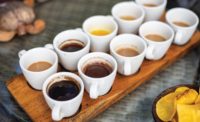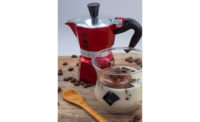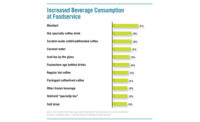Time for Tea
Tea and tea-like beverages, especially those with better-for-you enhancements, are flooding the marketplace


Great teas are brewing in the marketplace as drink crafters expand the boundaries of this ancient beverage.
Photo courtesy of: Enroot Organics, PBC

The green tea powder matcha has been used as a popular flavor and vivid green food color while contributing beneficial phytochemicals.
Photo courtesy of: Crave Natural, LLC/Yishi Foods

Tea is one of the oldest beverages, but more than a simple beverage, it’s associated with health and mood.
Photo courtesy of: Aiya America, Inc.

The combination of superfruits and tea has proven incredibly successful in the marketplace and has the power to remain trendy.
Photo courtesy of: TIC Gums, Inc.

Tea flavors work especially well in desserts, confections, and pastries, adding astringent herbal nuances to perfectly balance sweetness.
Photo courtesy of: Teariffic Ice Cream, LLC






Across the globe, drinking tea is second only to enjoying a glass of water. In 2020, according to the Tea Association of the US, American consumers drank more than 84B servings of tea. Tea’s future is also bright; today, US retail market sales for all forms of tea are around $13B. And those numbers are considerably magnified when you count all the beverages that consumers call “tea.”
Technically, true tea only includes what is derived from the leaves and flower buds of the Camellia sinensis shrub. Herbal teas and similar botanical beverages are not true teas. Herbals are made from bark, fruit, flowers, leaves, roots, and seeds.
According to a 2021 Mintel Food and Beverage report, top consumer trends are well-being, quality and flavor no matter the price, and "unity through food." Beverage developers have been eager to capitalize on these trends, and for good reason: Tea and tea-like beverages fit perfectly within the trends and reflect centuries of tradition.
Along with their nutritional and nutraceutical properties, tea beverages conform to a full range of price points, flavors, and occasions that bring a pleasurable experience for diverse groups.
Grown primarily in Asia, especially China and India, Camellia sinensis is to this day often harvested by hand. The tender leaves and buds are then processed in a variety of ways. For example, green tea is gently heated to minimize oxidation. For black tea (orange pekoe is a type of black tea), the leaves are fully oxidized with heat. Oolong tea involves a complicated, multi-step process. White tea is minimally processed and preferably dried without heat. These are just a few of the many types of—and processing methods for—true teas.
Sensationally functional
Tea has inherent functional benefits, including powerful antioxidant compounds such as polyphenols, catechins, flavonoids, anthocyanins, L-theanine, and caffeine. When balanced correctly, these components deliver not only on health but on product outcomes. They add refreshing notes to better-for-you beverages, ready-to-drink teas, functional waters, sparkling teas, seltzers, hard seltzers, cocktails, and mixers. Developers have limitless options for employing functional blends that address cognitive health, gut health, natural energy, stress relief, and relaxation. Tea concentrates and flavorants can take these healthful compounds beyond beverages into baked goods, glazes, ice creams, curry bases, soups, cereals, and snack bars.
Tea as a flavor
Tea extracts are flavors sourced from tea. According to a Markets and Markets report, the tea extract market will reach $3.8B by 2025, with green tea extracts leading the pack for beverages and other applications. Tea powders are dried tea leaves that range in granulation size. Tea powder particle size impacts flavor and solubility.
Concentrates are a double-strength brew. These brews are used in smaller amounts or diluted to regular strength before use as a beverage. Although they are used as flavorants, they can impart bitterness and need to be balanced with other ingredients to ameliorate any undesired flavor notes. Tea syrups are tea made with sugar, then concentrated. The sugar and tea flavors mix at specific levels for easy reconstitution. Syrups typically are sold at retail as a “just-add-water” ingredient.
The fine Japanese green tea powder known as matcha is the most common tea flavor used in food products and still is enjoying strong popularity more than a decade after it exploded onto the Western food and beverage scene. However, other tea flavors increasingly are finding their way into such products as candies, confections, and bakery. Other teas have excellent flavor profiles that make them attractive to product developers. Smoked teas, such as the aforementioned oolong, Keemun, and lapsang souchong, work particularly well in savory formulations such as sauces, stews, and condiments.
The tea extract market is forecast to reach nearly $4B in sales over the next several years, with green tea extracts the primary ingredient in the category.
Development is in the details
Time and temperature are critical. “Brewing tea is as much of an art as it is science and is critical to a successful outcome,” notes Anuhya Bhaskara. “Every tea has a ‘sweet spot’ for brew time and temperature. Carefully controlled brew conditions release aroma and flavor compounds unique to the tea and the brew method, creating nuances for a complex sensory outcome. The wrong brew conditions yield unpalatable characteristics like a weak cup, high degree of bitterness, astringency, and dryness.”
The crucial parameters for a consistent yield and great sensory experience are the grade of tea leaf used, brew temperature and time, and quality and chemistry of the water used.
Lindsay Wisener, co-founder of Wise Bev beverage development partners, shares: “Developers try multiple tea varieties, profiles, and blends to minimize changes during acidity adjustments. The same is true of heat. Heat is needed to create shelf-stable products. Developers must understand the amount of heat the product can withstand and still deliver the desired profile.”
A flavor profile must not only attract but keep a consumer’s interest. The flavor complexity of a brew is enhanced with blends of tea varietals and spices, flavors, and herbs.
Getting to flavor
Tea offers a comprehensive range of flavors based upon varieties, geography, soil, growing conditions, and processing steps. For example, oolong carries pit-fruit flavors and tropical flowery and earthy profiles. The lung ching tea variety (also called longjing) carries nutty flavor notes because of processing conditions.
Gunpowder tea, a tea common in Chinese restaurants in the 1960s, is enjoying a revival in popularity. It is a drum-heated green tea that has a light roasted vegetable flavor. Black, the most common type of tea, is available in a range of flavors. Full-bodied black teas tout chocolate, malt, and sweet notes. A smoked black tea profile has a charred pine base with a sweet aftertaste.
More neutral teas serve as the building blocks for a more sophisticated flavor profile. “A tea extract brings the flavor of the tea when combined with another flavor—for example, peach-oolong,” says Rachel Zemser, MS, CFS, CCS, a culinary scientist and product development consultant. “The tea flavor could compete with a strong fruit flavor. For the tea flavor itself to shine through, without overpowering, it must be boosted to be part of the duo flavor profile. A tea concentrate can help achieve just the right balance.”
Sweetness is a second factor. Tea extracts and powders typically do not have sweeteners added. Tea concentrates might have a sweetener added, and tea syrups do by definition. “The tea syrup, tea plus sugar, works well if the intention is to make a sweet tea beverage,” says Zemser. “Tea syrup combined with other fruit syrups can provide a similar effect to using an extract, except the sugar is already included."
While a proper tea syrup uses sucrose, with any sweetened tea concentrate, the sweetener type is critical. In addition to the sweetness they contribute, different sweeteners will react differently even if they have the same brix as sucrose. They will enhance or interact in various ways and impact flavor notes inherent in each of the beverage’s components.
Tea Innovations
Makers of both brew-ready tea and RTD tea beverages are “leafing” nothing behind when it comes to developing the next generation of tea drinks. Here are some beverage brands that have demonstrated noteworthy innovations in the category.
Read the leaves. Fraser Tea offers USDA-certified organic black tea blends like Poolside Piña Colada, Trappist Monk Blend, and ImmuniTEA in single-serve sachets and loose tea blends. Trappist Monk Organic Black Tea is Michigan cherries, vanilla, sweet caramel flavor, and Assam tea tempered with orange peel, pomegranate, and grenadine. ImmuniTEA Organic Rooibos Tea is a blend of ginger, pink peppercorn, lemon, cloves, and rooibos tea.
Star power. Enroot is a line of cold-brewed, organic botanical sparkling teas launched by actor Brad Pitt and friends. Two of the five flavor profiles are Relax with strawberry, lavender, rosemary, and tulsi; and Revive with apple, lemon, cayenne, and yerba maté.
Take good care daily. Atoka Herbal Tonics, developed by Ocean Spray’s R&D team, use lightly fermented tea in three blends: Calm with dark cherry, chamomile, hops, and ginger; Restore with cranberry, linden flower, lemon-grass, orange peel, and ginger; and Remedy with elderberry, reishi, rosehips, and ginger.
Spritz Tea, a lightly sparkling tea with no sugar or calories, comes in four flavors in a ready-to-drink can: Pink Guava, Bright Citrus, Wild Açai, and Golden Peach.
More in Store
Clever beverage crafters and product developers use tea in savory dishes, sauces, pastries, confections, fillings, and ice cream. The chefs at Charlie Baggs Culinary Innovations use tea when cooking with meats. Julie Luby, vice president of R&D says, “Our chefs use the chai tea bag contents as part of the rub for a meat dish.”
Award-winning chefs Robert and Molly Krause also use tea as a culinary flavor. They employ a tea, lime, and sugar combination to give a sweet-and-sour twist to salmon, trout, or black cod. The same three ingredients, varying the tea, spark up a fruit poaching broth, gelatin desserts, and granita.
One tea flavor developer shares additional uses and food-for-thought concepts using tea. These include: Smoked whiskey with a lapsang souchong-chai blend; toasted yerba maté incorporated into a cilantro lemon soup; Earl Grey tea and blood orange cream tart; Green tea-banana-chocolate muffins; and a peach-rooibos-honey ice cream.
Some like it cold
Cold tea beverages create an extra dimension of challenges for the beverage processor. Many cold tea beverages begin as brewed teas, and temperature is a key element in the flavor profile. This is due in large part to the role the olfactory sense plays in taste. When a hot beverage is imbibed, the steam transports the volatile flavorants inherent in the concoction to the chemical receptors in the nose, and in turn are translated as flavor.
Another challenge is that viscosity changes when a liquid is cooled, altering the organoleptic perception on the palate. In addition, as a liquid cools, certain compounds will separate from the matrix and alter their concentration throughout the beverage. This particularly applies to flavored and sweetened tea beverages.
Herbal teas ride the coattails of true teas and offer enhancements to tea profiles in today's beverage formulations.
Adding flavors to a warm brew and then chilling it can simultaneously diminish subtler flavors, such as fruit and spice, while enhancing other, sharper flavors. This is especially true of any minerals inherent in the water used for brewing and the tannins in the tea itself.
When attaining sweetness reduction via natural, high-intensity sweeteners, it’s necessary to balance the right blend of sweeteners with the levels of astringency (such as from the aforementioned tannins) of the specific types of tea used to minimize any distinct off-notes found in those sweeteners. Also, each type of sweetener will create a slight differences in sweetness intensity in relation to other ingredients and compounds in the liquid matrix. A good ingredient supplier will have technologists on hand to help product makers navigate these various challenges and find the right blend of teas, sweeteners, and added flavorants, for hot and cold formulations.
As a beverage and as an ingredient, tea taps into multiple trends and keeps consumers engaged. What started as a morning ritual or an afternoon delight is fully enjoyed anytime and anywhere throughout the world. For product developers, tea is in the now and in the future, steeped across the day, enjoyed as beverages or added as an ingredient in everything from sweet confections to savory dishes.
Looking for a reprint of this article?
From high-res PDFs to custom plaques, order your copy today!











